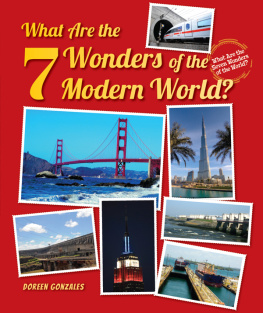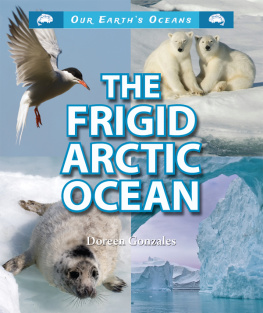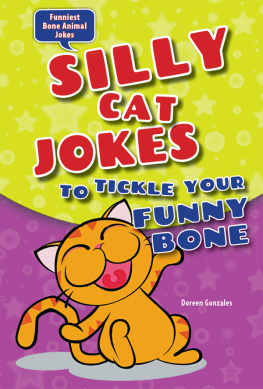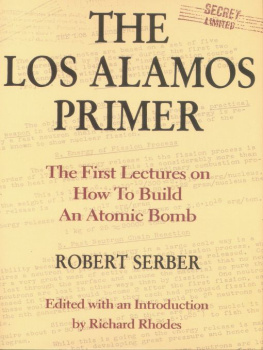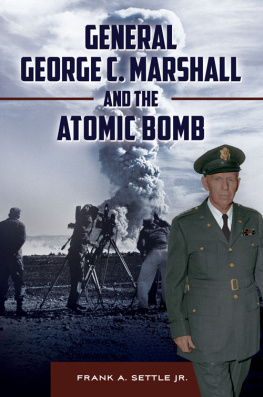Every living thing within a half-mile radius of ground zero had been killed instantly, including at least seventy thousand people
Thousands of American soldiers were dying and millions more were perishing during World War II. Some of the worlds greatest scientists escaped their own war-torn countries and f led to the United States. These scientists discovered a possible way to end the war. Thus began the threeyear experiment resulting in the production and use of the atomic bomb.
In The Secret of the Manhattan Project: Stories in American History, author Doreen Gonzales examines the creation of this powerful weapon and its place in the history of World War II. She presents the political, scientific, and social issues surrounding the bomb, and looks at todays issues about living in a world with nuclear weapons.
ABOUT THE AUTHOR
Doreen Gonzales spent eleven years as a teacher and is now a full-time writer. Her other books for Enslow Publishers, Inc., include A Look at the Second Amendment: To Keep and Bear Arms and Seven Wonders of the Modern World.

Image Credit: 2011 Photos.com, a division of Getty Images
Imagine keeping a secret among a hundred thousand people. Or hiding three whole cities. Envision gathering several of the most famous scientists in the world in one place for three years without anyone knowing where they were or what they were doing. Picture midnight escapes in small boats across icy oceans, or living next door to a fun-loving babysitter who was really a Russian spy. Imagine the vice president of the United States not knowing that people all across America were working day and night to build a new kind of weapon. Then imagine this weapon changing the course of history. This scenario reads like a movie script with an unbelievable plot. But it is not. These things really happened during the 1940s when the United States was working to develop the atomic bomb.
President Franklin Delano Roosevelt ordered the army to build the bomb in 1942. At that time, scientists did not yet know whether such a powerful weapon was even possible. Most speculated that, if it were, its development would take years. Thousands of complex mathematical calculations had to be made, and hundreds of questions still needed answers. And even if an atomic bomb were possible, making enough fuel for one might not be. This alone was such an immense manufacturing task that, as one scientist put it, the entire nation would have to be turned into a factory.

Image Credit: Department of Defense
With German shells screaming overhead, American seek shelter behind a tank. The ruins of the town of Geich, Germany, which was under shelling, can be seen in the background. This photograph was taken on December 11, 1944.
Military leaders saw another obstaclesecrecy. The world was engaged in World War II, and enemies of the United States were also working on atomic bombs. The country that built one first would probably win the war. This race made the smallest leak of information dangerous. Creating a nuclear weapon would require the help of thousands of people across the United States. In addition, the project would take years to complete. Could this many people keep a secret for this long?
The scientists who worked on the first atomic bomb knew they could change the course of history. In fact, many hoped to do just that. Their work brought science and politics together as had never been done before. However, the creation of the atomic weapon is more than just a lesson in history. It is one of the most fascinating stories of our time.
The atomic bomb had its roots in politics as much as in science. During the 1930s, Adolf Hitler rose to power as the chancellor of Germany. He was the leader of the National Socialist German Workers political party, or Nazi party for short.
The Nazis were angry that Germany had been divided into several small countries after losing World War I. They wanted to reunite these countries into one nation made up of people they called Aryans. The Nazis defined Aryans as a race of people native to western Europe. They believed Aryans were the only true Germans and were the best people in the world, the earths supreme race. The Nazis considered people of other backgrounds inferior and undesirable. They especially hated people of Jewish or Slavic heritage.
Hitler knew that many Germans would not agree with these racist ideas, so he said little about them to the general public. Instead, he talked about building a stronger nation and a healthy economy. These ideas appealed to Germans. After World War I, Germany was forced to pay huge sums of money to the countries that won as a punishment for having started the war. By the 1930s, the German economy was in a depression, and millions of Germans were unemployed. Their desperate predicament made Hitler popular, and in 1933 he became Germanys chancellor (chief minister of the nation).
For Hitler, this position was a stepping-stone to complete control. As chancellor, he had a lot of power, which he used whenever possible to get rid of government leaders who did not agree with his ideas. By the middle of 1934, Hitler had achieved a position of ultimate power. He was now Germanys dictator.
As Germanys sole ruler, Hitler began taking away freedoms. He forbade the countrys newspapers and radio stations to express opinions he did not like. He declared that all political parties were illegalexcept for the Nazi party. All German teenagers were forced to join junior military clubs in which they were taught Nazi beliefs. Children were told to spy on their parents and report any anti-Nazi talk they heard. When they did, their parents were often arrested.
Then Hitler began making laws against non-Aryans. His first law said that only Aryans could be public employees. Consequently, about ten thousand teachers, professors, and scientists were fired. Many were Jewish. Thousands of them left the country. Some moved to nearby countries, where they hoped they would be safe from Hitlers racism. Others traveled to Great Britain or to the United States. Germany lost about one fourth of its physicists as a result.
Hitler eventually enacted four hundred laws that discriminated against non-Aryans. One law forbid Aryans to marry Jews. Another said that Jewish people could no longer be German citizens. These new laws were enforced by German police called the Gestapo. The Gestapo jailed or killed anyone who disobeyed the Nazis. After each law was enacted, more Jews left Germany. When they did, the German government made it difficult for them to return.
Among the many Jews who fled Germany was famous scientist Albert Einstein. Einstein had been born in Germany in 1879. By 1905, he had earned a worldwide reputation as a brilliant physicist. He had been awarded the Nobel Prize in physicsone of the most prestigious awards in the worldin 1921. Still, Hitler branded Einstein as inferior because he was Jewish.
When Einstein visited the United States in 1933, the German government seized his property and took away his citizenship. But Einstein did not want to return to Germany. He believed the Nazis were turning Germany into a sick, destructive country.


